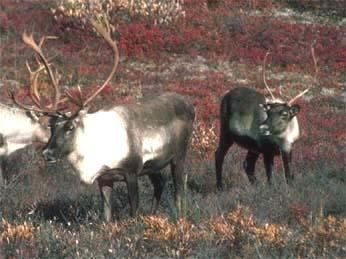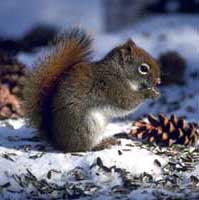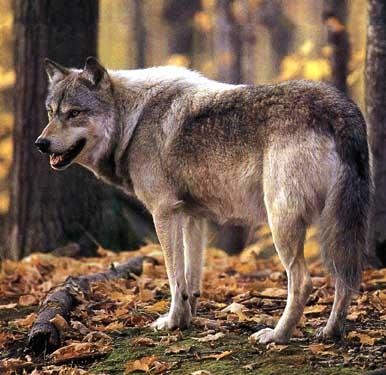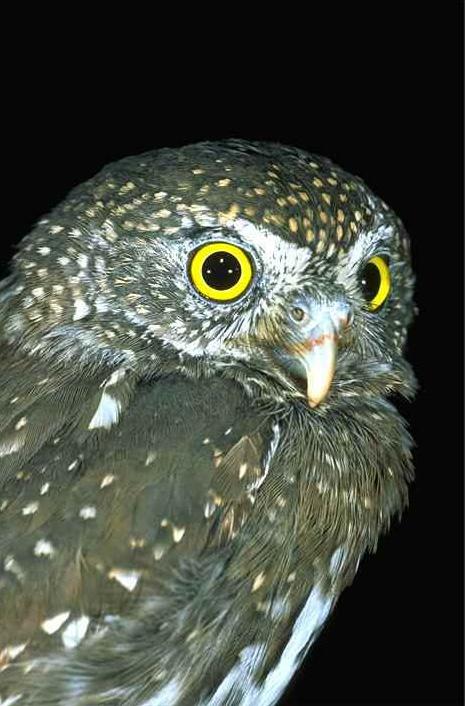The animal world of Karelia is very rich and multifarious. The number of vertebrates is more than 370 species, among which are mammals (63), birds (252), reptiles (5), Amphibians (5), and fish (53). Karelia, being located in taiga, has fauna that much reminds of woods.
 The Karelian fauna is comparatively young. It was formed during the last ice age, in other words, during the last 10-15,000 years. The beginning of this process belongs to the times, when the territory of contemporary Karelia had become free from the waters of the Baltic-Belomorskiy basin and began to cover itself with taiga’s and forest-tundra’s flora. During this period, known as the Ioldievo times, many species of arctic animals and birds reached Karelia. The first were inhabitants of the seaside and lakes, such as sandpipers, looms, geese, ducks, ptarmigan, reindeer, lemming, Arctic fox and others. It’s necessary to attribute to emigrants, that had occupied the reservoirs of Karelia, such fish as eel-pot, stream trout, white-fish, lake smelt and others.
The Karelian fauna is comparatively young. It was formed during the last ice age, in other words, during the last 10-15,000 years. The beginning of this process belongs to the times, when the territory of contemporary Karelia had become free from the waters of the Baltic-Belomorskiy basin and began to cover itself with taiga’s and forest-tundra’s flora. During this period, known as the Ioldievo times, many species of arctic animals and birds reached Karelia. The first were inhabitants of the seaside and lakes, such as sandpipers, looms, geese, ducks, ptarmigan, reindeer, lemming, Arctic fox and others. It’s necessary to attribute to emigrants, that had occupied the reservoirs of Karelia, such fish as eel-pot, stream trout, white-fish, lake smelt and others.
Further warming of a climate and clearing of water of the increasing sites of a land have resulted in a wide expansion of wood vegetation in Karelia and intensive settling of this territory by species both from the north-east (taiga fauna), and from the south (European fauna of deciduous woods and steppe). From the east and the north-east have penetrated here a tiny shrew, wood lemming, red and red-grey field-voles, flying squirrel, goose, three-fingered woodpecker, lentil, green chiff-chaff, bullfinch, yellow-hammer, viviparous lizard, whitefish; from the south and the south-west – a hedgehog, wood marten, mink, black polecat, ordinary field-vole, garden dormouse, yellow-throated mouse, warbler, blackbird, grass-snake, Atlantic sturgeon, chub, rudd, gudgeon, pike perch and others.
 In the following Atlantic epoch, characterized by a warm and damp climate, deciduous, mixed and pine wood achieved the maximum development in Karelia, and the fauna become more modern and typically gained a more wood-like appearance. It was confirms br the remains of animals, found at archaeological excavations on Ladozhskiy and Onezhskiy sites of a prehistoric man (their age is defined as 4-8,000 years). Among the mammals there were a seal, hare, beaver, water-rat, sable, marten, polecat, otter, wolf, fox, two kinds of dogs, brown bear, reindeer, moose, flat-forheaded bull; among the birds - golden eagle, buzzard, sea gulls, hawks, crow, wood grouse, blackcock, white partridge, goose, swan and various kinds of ducks; among fishes – catfish, pike perch, eel-pot, white fish, perch, roach and others. Most of them belong to typically wood (taiga) kinds of animals, but alongside with them at excavations of the Neolithic sites, forest-steppe’s species were also found – bison, aurochs, roe, wild boar, wild cat, grey heron and others. It is evidence that deforestation at that time was probably mildly.
In the following Atlantic epoch, characterized by a warm and damp climate, deciduous, mixed and pine wood achieved the maximum development in Karelia, and the fauna become more modern and typically gained a more wood-like appearance. It was confirms br the remains of animals, found at archaeological excavations on Ladozhskiy and Onezhskiy sites of a prehistoric man (their age is defined as 4-8,000 years). Among the mammals there were a seal, hare, beaver, water-rat, sable, marten, polecat, otter, wolf, fox, two kinds of dogs, brown bear, reindeer, moose, flat-forheaded bull; among the birds - golden eagle, buzzard, sea gulls, hawks, crow, wood grouse, blackcock, white partridge, goose, swan and various kinds of ducks; among fishes – catfish, pike perch, eel-pot, white fish, perch, roach and others. Most of them belong to typically wood (taiga) kinds of animals, but alongside with them at excavations of the Neolithic sites, forest-steppe’s species were also found – bison, aurochs, roe, wild boar, wild cat, grey heron and others. It is evidence that deforestation at that time was probably mildly.
About 3-6,000 years B.C. the warm and damp Atlantic period changed into dry and hot sub-real, and then turned into more damp and cold climate of sub-Atlantic period (1-3, 000 years B.C.). During this time dark coniferous woods were very widespread in Karelia, and deciduous forests began to recede. Accordingly,in fauna, the number of taiga woods animals began to increase, coming from the north and the east. That were a squirrel, glutton, brown bear; among birds - hazel grouse, wood grouse, owls, woodpeckers and many others. Further, already in historical time, the formation of fauna went under direct or indirect influence of man.
The variety of natural conditions, connected with great extent of the territory from the north to the south and man’s industrial activity, changing the landscape, alongside with historical features of fauna formation, causes a conjoint expansion of species with different requirements to the environment within Karelia, and determines the mixed structure of fauna.
 A shrew is the tiniest animal in Karelian taiga; its weight is 2-3 kg. A moose is the biggest animal; its weight can be up to 400 kg. Moose are numerous and are always a desired hunting trophy. A brown bear is another dream of many hunters. Its population on the territory of Karelia is also very numerous. It’s rarely possible to meet a bear in the woods – it leads rather a night way of living. It is very careful and always tries to make way for a man. A wood reindeer is also one of the largest animals in Karelia (its weight is up to 190 kg.). Unfortunately, its population is decreasing. Today this species is found only in the northern parts of Karelia and in Pudozhskiy region, where it gets to from the Arhangelsk area.
A shrew is the tiniest animal in Karelian taiga; its weight is 2-3 kg. A moose is the biggest animal; its weight can be up to 400 kg. Moose are numerous and are always a desired hunting trophy. A brown bear is another dream of many hunters. Its population on the territory of Karelia is also very numerous. It’s rarely possible to meet a bear in the woods – it leads rather a night way of living. It is very careful and always tries to make way for a man. A wood reindeer is also one of the largest animals in Karelia (its weight is up to 190 kg.). Unfortunately, its population is decreasing. Today this species is found only in the northern parts of Karelia and in Pudozhskiy region, where it gets to from the Arhangelsk area.
The most interest specimen of fauna is a beaver. It is famous first of all for its building skills. It digs channels, erects huts and dams about dozens lengthwise, and sometimes even hundreds of meters. It’s easy to see its traces of activity, but the master itself is almost always out of a sight: it works on nights and comes out on land very seldom.
Not long ago wild boar and raccoon dog appeared in Karelia. Nowadays both of these species have become objects of sports hunting.
Two more species - American mink and musquash - were purposefully brought on the territory of the republic and now are common trade animals.
The full list of shooting animals of Karelia includes 25 species. Some of them – an elk, brown bear, reindeer, wild boar, wolf, lynx and fox - may be objects of hunting tourism.
The reptiles and amphibians of Karelia include 4 taiga types (40%), 3 kinds of trans-artic expansion (30%) and 3 southern species, typical for European deciduous woods. The first group includes a viviparous lizard, viper, grassy and sharp-faced frog; the second – a toad and ordinary triton; the third –a lizard, grass-snake and collar triton. The Karelian fauna of surface vertebrates on 35% consists of the West European and Southern species, typical for deciduous woods, on 33% - species, which are wide spread in Eurasia, on 24% - taiga and Siberian kinds, and about 9% are Artic (polar) types. All of them, with the exception of a viper, are not only harmless, but rather useful. The bite of a viper also doesn’t do much harm to your health, but it’s very painful. As a rule, a viper tries to make way for a man, though it is unlikely to happen because of viper’s natural slowness. People are usually cruel toward it. The same falls to a legless lizard’s share. It’s a harmless and useful reptile, which is usually recognized as a snake.
The world of birds is also luxuriant in Karelia. It counts more than 260 types, among of which about 200 are nestling. The majority of birds are the birds of wood landscape – approximately 60%; a significant group (30%) relates to reservoirs and less than 10% prefers open lands. About 34% of birds finds in Karelia the northern expansion limit, and 12% - the southern.
Perhaps, the most popularity among wood birds belongs to a wood grouse and a black grouse. Both of them are the most desirable hunting gamebirds, but they are especially famous for their courtship rituals perform in the spring, accompanied by original ceremony and unusual songs. To present at such displays means to enrich with the whole range of unforgettable impressions.
 A song-thrush and a nightingale are the best “soloists” of the Karelian thicket; they also belong to the wood birds. It’s not a miracle to hear a sonorous bird’s dissonance in the spring, but only a nightingale singing is possible to listen with delight. It’s practically impossible to see the small grey bird, singing in twilight or night, but its voice stands out against a background of common chorus with its beauty and gorgeousness of sounds. A song-thrush has its own bright and none less sonorous song. It performs a song, sitting on the top of any tree, so it is easy to see the bird. The other Karelian thrushes such as red-wings, field fares, and blackbirds have songs that are much more barren.
A song-thrush and a nightingale are the best “soloists” of the Karelian thicket; they also belong to the wood birds. It’s not a miracle to hear a sonorous bird’s dissonance in the spring, but only a nightingale singing is possible to listen with delight. It’s practically impossible to see the small grey bird, singing in twilight or night, but its voice stands out against a background of common chorus with its beauty and gorgeousness of sounds. A song-thrush has its own bright and none less sonorous song. It performs a song, sitting on the top of any tree, so it is easy to see the bird. The other Karelian thrushes such as red-wings, field fares, and blackbirds have songs that are much more barren.
It’s hard for the birds to live in winter, but even in the sharpest frosts, crossbills grow their fledglings in crowns of conifer trees. A dark-brown bird with a white spot on its chest also amazes everyone in winter. It’s possible to see and hear it near non-freezing rapids on streams and rivers. The bird, as a rule, sits on stones or on pendent over the water snowy banks and from time to time bravely plunges into the impetuous water. It can perfectly dive, swim and run at the bottom, gathering aquatic insects and their grub.
In summer it is occasionally possible to see a golden eagle and erne in flight. These big birds of prey undoubtedly are adornments of birds’ community, but their population is rapidly decreasing, that’s why these kinds of birds are recorded in The Red Books of Russia and Karelia. And, of course, a swan is notable for its beauty and size among water birds. This graceful and snow-white bird (its weight is up to 13kg.) is very widespread all over Karelia, but is not numerous. It has also a loud blaring voice.
About 30 types of nestling birds live at the White Sea. There are especially animatedly during a flight. Thousands of flocks of scoters, brand gooses and other birds stick to the water and banks during feeding and rest.
The meadows and fields of Olonetskoi plain attract tourists’ attention. It is a place of staying for thousands of flocks of different kinds of gooses during a flight.
There are about 50 types of fish in the lakes and rivers of Karelia. The majority of species are registered in the Ladozhskiy (42) and Onezhskiy (35) lakes. As moving to the north, their number is decreasing. The salmon family belongs to the number of the most valuable fish. There are limiting values of a pike perch, perch, pike, and grayling in large lakes. All these fish are perfect objects of fishing tourism. About 70 kinds of fish and their sorts live in the White sea. Herring, navaga, cod, flounder, salmon, white-fish, and smelt are the basic trade fish.
When talking about the world of insects, numbers more than 3000 kinds in Karelia. It is necessary to mention the useles mosquito. It is an object of constant jokes, fairy-tales and damnations. By the way, among the stinging insects the mosquito is the most harmless.
